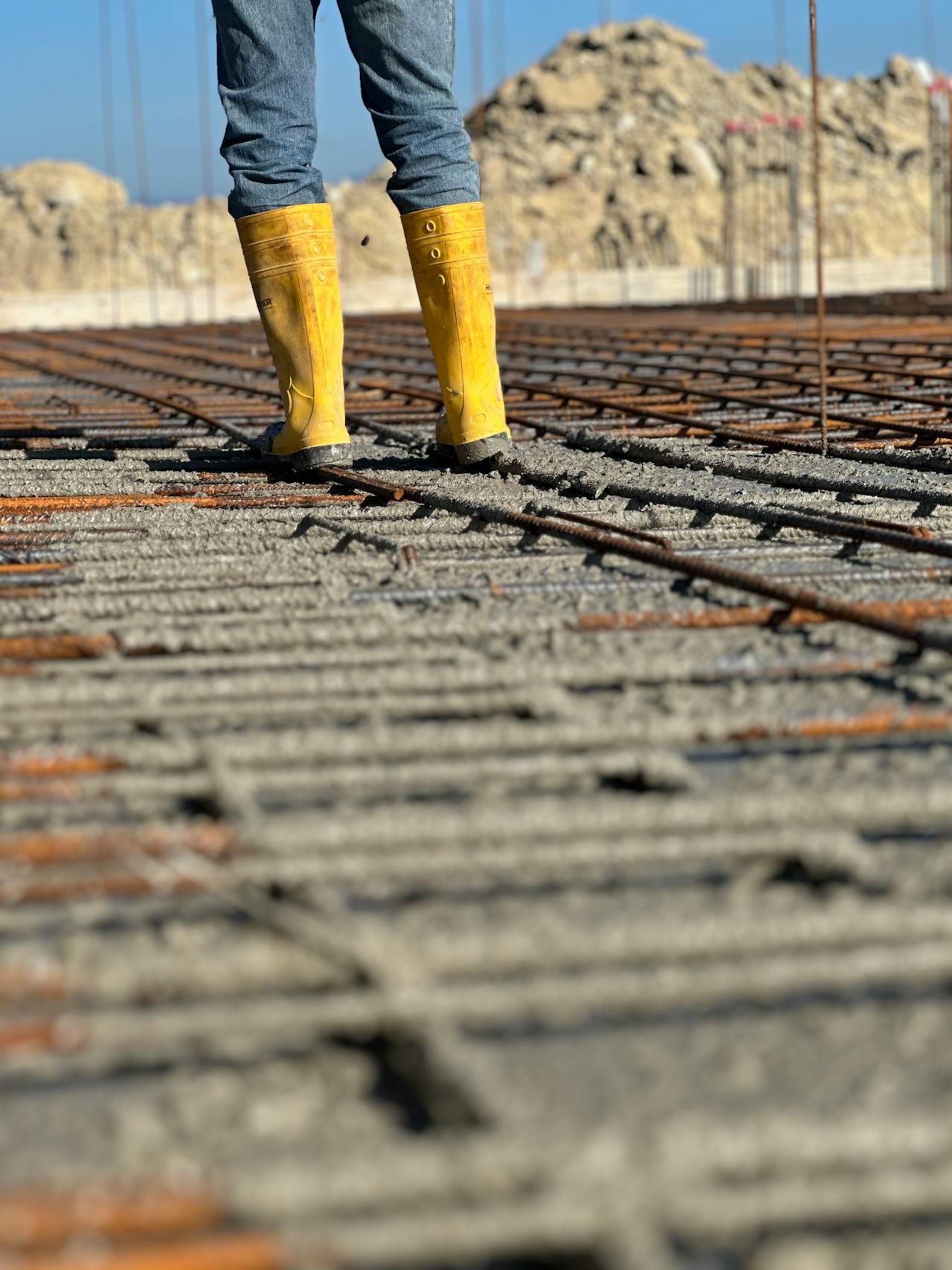The construction industry is at a critical point in addressing climate change, with embodied carbon becoming a key focus for environmental responsibility. When building retail shells for our clients, we consider not only the structure that will house their business but also the carbon footprint embedded within every beam, panel, and foundation element.
Embodied carbon includes all greenhouse gas emissions released throughout a building’s material lifecycle—from the quarrying of raw materials to manufacturing processes, transportation to construction sites, installation methods, and eventually, demolition and disposal. For retail developments, these emissions represent a significant environmental impact that occurs before a single customer enters. As general contractors, we’ve noticed how the importance of these upfront carbon costs has grown—now accounting for approximately 49% of a new retail building’s total carbon emissions over its lifespan.
The unique characteristics of retail shells—typically featuring large open floor plates, significant structural spans, and distinctive façade elements—present both challenges and opportunities in our carbon reduction strategies. In the current construction landscape, where developers like Hines and organizations such as the World Green Building Council are promoting accountability, we’ve adapted our methods to prioritize material selection and construction practices that minimize this invisible yet impactful environmental cost. When Chicago’s latest mixed-use development broke ground last quarter, the project’s carbon footprint was scrutinized as thoroughly as its financial projections—a trend increasingly seen across the retail development sector.
Why is Benchmarking Critical for Retail Shell Carbon Reduction?

In the competitive landscape of retail construction, carbon benchmarking has become an essential tool for measuring and ultimately reducing the environmental impact of building projects. We establish precise baseline measurements that enable our teams, along with developers and property owners, to make data-driven decisions throughout the construction process. Without these benchmarks, carbon reduction efforts remain abstract rather than actionable.
Benchmarking isn’t merely about collecting data—it’s about creating a framework for continuous improvement. By tracking embodied carbon across retail shell construction projects, we identify high-impact areas where material substitutions or modified construction techniques can yield significant emissions reductions. The construction materials selected during preconstruction often account for the largest share of a project’s carbon footprint, making early benchmarking particularly valuable.
Creating Reliable Baselines for Decision-Making
Our approach to benchmarking begins with comprehensive data collection that captures the carbon intensity of various construction materials and methods. We’ve found that establishing detailed baselines allows us to track performance against specific targets rather than working with vague sustainability goals. This precision is particularly important in retail construction, where tight schedules and standardized designs create both challenges and opportunities for carbon reduction.
When benchmarking a retail project, we analyze everything from foundation systems to envelope materials, identifying where emissions can be meaningfully reduced without compromising structural integrity or aesthetic requirements. This data becomes a powerful decision-making tool during value engineering, allowing our teams to suggest alternatives that reduce carbon while staying within budget parameters.
Effective benchmarking requires standardized methodologies to ensure consistent measurement across different retail projects. We utilize life cycle assessment (LCA) protocols that account for emissions from raw material extraction through manufacturing, transportation, installation, and eventual disposal or recycling. This cradle-to-grave approach provides a comprehensive picture of a project’s true carbon impact.
Benchmarking as a Competitive Advantage
The market for sustainable retail spaces continues to grow as brands recognize the value of low-carbon facilities in meeting corporate environmental goals. By implementing robust benchmarking practices, we position our clients to demonstrate measurable carbon reductions to stakeholders, including consumers increasingly concerned about environmental impact. Retail developers who can quantify their carbon reduction efforts gain a distinct advantage in attracting sustainability-focused tenants.
Environmental product declarations (EPDs) have become essential tools in our benchmarking process, providing third-party verified documentation of a product’s environmental impact. We integrate EPD data into our material selection process, enabling direct comparisons between different products’ carbon profiles. This transparency allows us to make recommendations based on verified environmental performance rather than vague “green” claims.
Data quality remains a critical challenge in carbon benchmarking. We address this by implementing rigorous verification protocols and cross-referencing multiple data sources to ensure accuracy. Our benchmarking systems are designed to flag outliers or inconsistencies that might compromise the integrity of carbon reduction strategies. This attention to data quality ensures that the carbon reductions we achieve are real and measurable.
How Do Current Standards and Tools Support Retail Shell Carbon Benchmarking?

The construction industry’s focus on carbon accountability has led to several robust frameworks for retail shell development. The Greenhouse Gas Protocol forms the foundation for most carbon accounting methodologies today, providing the structural backbone for categorizing, measuring, and reporting emissions throughout the building lifecycle.
In retail shell projects, our teams use the GHG Protocol’s three-scope framework to categorize emissions effectively. Scope 1 covers direct emissions from owned sources, Scope 2 includes indirect emissions from purchased electricity, and Scope 3 encompasses all other indirect emissions in a company’s value chain—where embodied carbon in construction materials typically falls.
GHG Protocol: The Industry Standard
The GHG Protocol’s sector-specific guidance offers standardized methodologies that integrate smoothly with existing corporate carbon reporting requirements. This alignment is particularly valuable for national retailers needing consistent carbon accounting across multiple shell developments in various jurisdictions.
Retail developers appreciate the Protocol’s cross-sector tools, which provide comprehensive emission factors for stationary combustion, purchased electricity, and mobile emissions sources. These resources enable our project teams to develop reliable inventories of GHG emissions that withstand third-party verification and align with increasingly stringent regulatory requirements.
Unlike generic carbon calculators, the Protocol’s tools reflect best-practice methods extensively tested by industry experts. Each calculation follows transparent methodologies that have become the de facto standard for carbon reporting in construction projects worldwide.
EC3: Making Material Carbon Data Accessible
The Embodied Carbon in Construction Calculator (EC3) marks a significant advancement in effectively benchmarking retail shells. This free, cloud-based tool allows our preconstruction teams to compare and evaluate embodied carbon emissions for building materials during the specification and procurement phases.
EC3’s strength lies in its material-centric approach. Rather than treating the building as a monolithic carbon entity, it breaks down emissions by material category, allowing targeted optimization where it matters most. For retail shells, this granularity helps us focus carbon reduction efforts on high-impact elements like structural systems and envelope components.
The tool interfaces directly with Environmental Product Declarations (EPDs), establishing a common language for carbon comparison across material categories. This standardization helps overcome one of the most persistent challenges in carbon benchmarking: inconsistent reporting methodologies between manufacturers.
Addressing Data Quality Challenges
Both frameworks address the critical issue of data quality, a persistent challenge in carbon benchmarking. The Protocol provides standardized quality indicators that evaluate completeness, temporal relevance, geographical specificity, technological representativeness, and methodological consistency. These indicators give developers a clear picture of where uncertainties exist in their carbon calculations.
We regularly encounter variations in EPD data quality across material suppliers. Some manufacturers provide detailed, third-party verified declarations, while others offer limited or self-declared information. This inconsistency has traditionally made like-for-like comparisons difficult for retail developers seeking to benchmark their shells against industry averages or competitor projects.
EC3’s data quality rating system addresses this challenge by providing transparency into the underlying quality of EPDs. The tool’s five-point rating scale evaluates factors like verification status, specificity, and temporal relevance, allowing our teams to make informed decisions despite varying data quality.
Practical Implementation for Retail Shells
Implementing these tools requires careful consideration of project boundaries and scope. For retail shells, we typically establish system boundaries that include substructure, superstructure, and envelope components while excluding tenant improvements that will occur later. This boundary definition ensures consistent benchmarking across different retail shell types.
Time boundaries present another consideration. The GHG Protocol distinguishes between cradle-to-gate (A1-A3), construction process (A4-A5), use (B1-B7), and end-of-life (C1-C4) stages. For retail shells, we frequently focus on cradle-to-gate emissions for initial benchmarking while developing separate tracking mechanisms for construction-phase emissions that fall under our direct control.
Practitioner decisions significantly impact benchmark results. Choices about which materials to include, how to handle data gaps, and which emission factors to apply can all affect the final carbon tally. The GHG Protocol’s standardized methodologies help minimize these variations by establishing consistent accounting procedures.
What Are the Primary Contributors to Embodied Carbon in Retail Shells?

When constructing retail shells, several key components contribute significantly to the embodied carbon footprint long before the first customer enters. Identifying these carbon hotspots is crucial for our teams as we develop strategies to reduce environmental impact without compromising structural integrity or project timelines.
Structural Systems: The Foundation of Carbon Impact
The superstructure is the largest contributor to embodied carbon in retail shells, accounting for approximately 40% of total emissions. This includes the concrete foundations, steel framing, and reinforcement materials that form the building’s skeleton. In our projects across various soil conditions, foundations alone can contribute up to 42% of a structure’s embodied carbon, with reinforced concrete being particularly carbon-intensive due to both the cement manufacturing process and the steel reinforcement.
Today’s retail environment often requires column-free, open floor plans that necessitate substantial structural elements. The steel beams and columns we specify typically account for 30-39% of the shell’s embodied carbon, especially when long spans are needed for merchandising flexibility. Recent material analysis shows that steel’s impact stems primarily from its energy-intensive production process, with each ton of structural steel generating approximately 1.46 tons of CO2e.
General Construction Works: The Hidden Carbon Contributors
Beyond the primary structure, general construction works represent about 24% of embodied carbon in typical retail shells. These elements include cement mortar, concrete blocks, and masonry systems used in wall construction. Research indicates that cement mortar alone can account for 42% of a retail shell’s embodied energy and 51% of its global warming potential, making it a critical focus area for our carbon reduction strategies.
We’ve observed that extruded polystyrene, commonly used in façade sandwich panels for retail shells, contributes disproportionately to carbon emissions relative to its weight. Though representing only about 0.29% of a typical shell’s total mass, this insulation material can account for 8% of embodied energy and 7% of embodied carbon, highlighting the importance of material selection beyond just structural components.
Building System Components and Finishes
The remaining embodied carbon in retail shells comes from electrical works (approximately 15%), HVAC systems (8%), cladding materials (7%), and fire safety systems (6%). While individually smaller contributors, collectively these systems represent a substantial portion of a shell’s carbon footprint. The metal sheet coverings used in roofing systems and bitumen waterproofing membranes are particularly carbon-intensive relative to their functional role.
For a typical retail shell with concrete construction, we typically see an embodied carbon intensity ranging from 20-25 kg CO2e per square foot, but this can vary significantly based on design decisions, material specifications, and regional supply chains. Current research shows that in European retail shells, the embodied energy intensity averages around 4,248 kWh/m² while embodied carbon averages 1,689 kg CO2e/m².
Material Selection Impact and Optimization
Our experience with retail shell construction has demonstrated that material substitution can yield substantial carbon reductions. For instance, replacing extruded polystyrene panels with stone wool sandwich panels for façades can significantly reduce carbon impact while maintaining thermal performance. Similarly, selecting metal sheet coverings instead of bitumen-based materials for roofing systems reduces embodied carbon without compromising functionality.
The fundamental challenge we face is that materials with the highest structural efficiency often carry the largest carbon footprint. Recent analyses of retail buildings indicate that while concrete and steel remain essential for structural integrity, optimizing their use through advanced design approaches can reduce overall quantities by 15-20%. For example, reducing column sizes where loads permit, optimizing slab thicknesses, and exploring alternative foundation designs can all contribute to lower embodied carbon while maintaining structural performance.
Construction and Assembly Methodologies
Beyond material selection, how we construct retail shells significantly impacts embodied carbon. Prefabrication and modular construction approaches can reduce material waste by 15-20% compared to traditional on-site methods. Additionally, these approaches typically require less concrete for structural elements and can utilize more efficiently dimensioned components.
Our construction workflows now incorporate carbon benchmarking across different stages, allowing us to identify opportunities for reduction in real-time. The construction phase itself accounts for approximately 7-10% of a retail shell’s lifecycle carbon footprint, through equipment emissions, material transport, and temporary works. By optimizing construction sequencing and equipment selection, we’ve achieved carbon reductions of 5-8% on recent retail projects without affecting completion timelines.
Understanding these primary contributors to embodied carbon enables our team to develop targeted strategies for more sustainable retail shells, balancing performance requirements with environmental responsibility throughout the construction process.
Conclusion: Turning Benchmark Data into Low-Carbon Retail Shells
Embodied carbon is no longer an abstract metric tucked away in sustainability reports. It is a hard-number cost that investors, tenants, and regulators scrutinize with the same rigor as project budgets.
Our industry’s challenge is clear: steel, concrete, and insulation choices made in pre-construction can lock in almost half of a retail building’s lifetime emissions before the first tenant improvement even begins. Effective benchmarking—grounded in GHG-Protocol accounting and powered by tools like EC3—turns that challenge into an opportunity. By identifying carbon “hotspots” in structural systems, façade assemblies, and general works, project teams can target substitutions and design optimizations that trim tonnes of CO2e without derailing program or cost.
Yet data only matters when it drives action. Successful carbon-smart retail shells depend on early collaboration among owners, designers, and contractors; rigorous verification of Environmental Product Declarations; and a willingness to rethink traditional construction sequences through prefabrication and modular techniques. When those pieces come together, embodied-carbon cuts of 20–30 percent are not just theoretical—they are proven, bankable outcomes that boost asset value and brand credibility.
Ready to translate benchmarks into real-world reductions on your next retail development? EB3 Construction has the field expertise to deliver shells that hit both your timeline and your carbon targets. Connect with our team today to chart a lower-carbon path from groundbreaking to grand opening.




